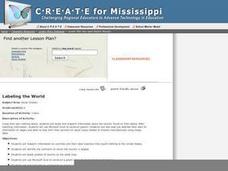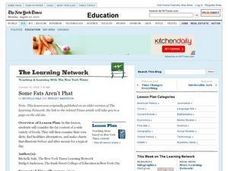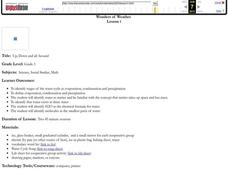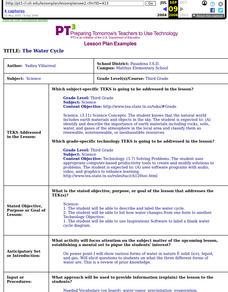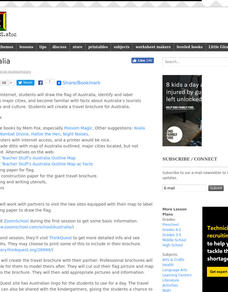Curated OER
Food Labels Lesson
Students analyze nutrition by completing an interactive activity with classmates. In this food choice lesson, students discuss the importance foods have on our daily lives by keeping us healthy and giving us energy. Students examine food...
Curated OER
Sugar-Coating the Facts
Learners explore the food industry's influence on American Student nutritional habits and analyze the nutrition charts found on food packaging. They design their own warning labels for foods targeted at Students.
Curated OER
Labeling the World
Sixth graders conduct research on the countries found on the labels on their clothing. They locate the countries on a map, research the labor practices on countries that export clothing to the U.S., and create a graph using the information.
Curated OER
P.C. Games
Discuss and share opinions on violent computer games. After reading an article, your class will discover the controversy surrounding online games. They analyze the suitability of computer games and write their own letters to a developer...
Curated OER
Bizarre Food
Students research foods from other countries. In this multicultural food instructional activity, students view a list of foods that kings and queens ate on an overhead transparency and go to the website www.jamessolheim.com/teachers1.htm...
Wuthering Heights
Wuthering Heights
Finally, a reason to use those digital devices in class! Many readers appreciate the convenience of accessing reading material on digital devices. A convenient eBook contains the entire text of Emily Bronte's Wuthering Heights in digital...
Curated OER
"The Drum"
Second graders read and discuss the folktale "The Drum" from India. They also answer story comprehension questions, complete an adjectives and verb worksheet, and label a map of India. Students sequence events from the story and make...
Curated OER
Some Fats Aren't Phat
Students examine nutritional information on various food labels and then consider the nutritional value of the foods in their own diets. They create posters illustrating their diets "before" and "after" they considered their fat intake.
Curated OER
Mathematics & Nutrition
Learners apply math to calculate fat and calories in the food they eat. They examine food package information to become aware of the ingredients and to learn about healthy life styles. They work in groups to create crazy meals using the...
Curated OER
When Something's Missing: Diagnosing Vitamin Deficiencies
The New York Times "Education" section posts an extensive lesson on vitamin and mineral deficiencies. It involves class discussion, examination of food packaging labels, and the reading of a blog post about Vitamin D. The highlight of...
Curated OER
Wonders of Weather
Fourth graders complete activities to study weather and the water cycle. In this water cycle lesson, 4th graders observe a demonstration of the three stages of water. Students work in groups to complete a water cycle lab activity....
Curated OER
An Eye on Science
Learners investigate the human eye and its parts. They read and discuss various books about eyes and sight, draw a rough draft of an eye diagram, and create a final draft of their eye diagram including labeled parts using Kid Pix...
Curated OER
Summer Trip
Fourth graders search for information and directions to specific cities from their homes, figure cost of trip when given miles per gallon, distance, and cost per gallon of gas, develop outline budget for summer trip, and draw and label...
Curated OER
The Water Cycle--Using Inspiration Software
Third graders describe and label the water cycle, and list how water changes from one form to another; students use Inspiration Software to label a blank water cycle diagram.
Alabama Learning Exchange
Flutter By, Butterfly!
Students examine the basic characteristics of butterflies. They view a butterfly PowerPoint presentation, complete various labelling activity sheets, explore websites, and design a poster that includes facts and illustrations to be used...
Curated OER
The 400-acre wood
In this forest planning lesson plan, students visit the 400-acre wood website and work in groups to learn about the specific aspects of forest development. Students create, label and color a forest planning map and present their map...
Curated OER
Maps
Maps, globes, and computer software aid young explorers as they locate state capitols, major cities, geographic features, and attractions for states they are researching. They then use desktop publishing software to create a map to share...
Curated OER
Australia
Students research Australia using the Internet. They draw a flag, identify and label Australia's major cities. They discover facts about Australia's tourists attractions and culture. They design a travel brochure using the facts.
Curated OER
Pennsylvania Colony
Students research the main reasons for the colonists moving to the Pennsylvania colony. They analyze maps, label a bubble map, list similarities/differences of immigrants then and now, and create a colonial newspaper advertisement.
Curated OER
Ocean Poster
Students discover ocean life by creating a mural. In this ocean biology instructional activity, students utilize a computer to find images of the ocean that can be used to create a collage. Students discuss the different...
Curated OER
Africa Unite!
Students work in pairs to research assigned African countries. They compile their research to label a continent map of Africa, present their research to the class and design a game of trivia using their findings.
Curated OER
Fruits of the Rain Forest
Sixth graders research rain forests and complete activities for the topic. In this rain forest lesson, 6th graders learn vocabulary about rain forests and research online for rain forest facts. Students research the layers of the rain...
Curated OER
Fearing the Fear Factor
Students write a reaction paper on the topic: "Reality shows like 'Fear Factor' are dangerous/nothing to worry about because...." Students respond to the situation Akron, Ohio's First Energy Corporation being labeled irresponsible after...
Curated OER
Humorous Satire? Or Is It?
Students establish background regarding a controversial article regarding rape. Students determine whether this article achieved the label of "satire". Internet sites are used for reference.


